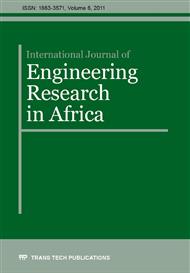p.1
p.13
p.25
p.37
p.45
p.65
p.75
The Effect of Image Resolution on the Geometry and Topological Characteristics of 3-D Reconstructed Images of Reservoir Rock Samples
Abstract:
The effect of image resolution on the measured geometry and topological characteristics of network models extracted from 3-D micro-computer tomography images has been investigated. The study was conducted by extracting geologically realistic networks from images of two rock samples, imaged at different resolutions. The rock samples involved were a Castlegate Sandstone and a Carbonate-28 reservoir rock. Two-dimensional images of these rocks were obtained at a magnification of ×50. The carbonate sample was studied at two different resolutions of 0.133 microns and 1.33 microns, while the sandstone was studied at 5.60 microns. Three-dimensional images of these 2-D images were obtained via image reconstruction, to generate the pore architecture models (PAMs) from which networks models of the imaged rocks were extracted with the aid of Pore Analysis software Tools (PATs). The measured geometry and topology (GT) properties included Coordination Number, Pore Shape Factor, Pore Size Distribution, and Pore Connectivity. The results showed that the measured geometry-topology (GT) characteristics of a network model depend greatly on the image resolution used for the model. Depending on the micro-structure of the reservoir rock, a minimum image resolution is necessary to properly define the geometrical and topological characteristics of the given porous medium.
Info:
Periodical:
Pages:
37-44
Citation:
Online since:
November 2011
Authors:
Price:
Сopyright:
© 2011 Trans Tech Publications Ltd. All Rights Reserved
Share:
Citation:


